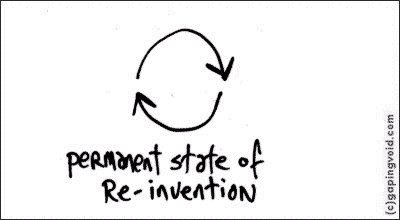
In the era of the “new” social Web, communications is actually evolving back to its origins of communicating with people, not at them. It may seem implied, but communications does not, for the most part, embody two-way discussions.
Over the years, communications has evolved into a one-way distribution channel that broadcasts messages at target audiences. In the process, communications stopped being about communication, focusing instead on the marketing aspects of top-down message push and control, what we now commonly refer to as marketing communications aka marcom. Marcom embodies traditional and new marketing branches that include advertising, PR, Web/interactive, event, among many other disciplines (depending on the organization).
With the soaring popularity and adoption of Social Media, companies are realizing that in addition to marketing communications, listening and engagement is quickly becoming pervasive and necessary in order to compete for precious, yet thinned and distributed attention. The days of focusing solely on Web stickiness, eyeballs and clickthroughs are fading. These are the days of immersion, conversations, engagement, relationships, referrals, and action.
So what do we call this important and history making transformation?
Some call it Social Media Marketing, others refer to it as Conversational Marketing, and factions of other thought leaders simply classify it as the socialization of the media and marketing in general.
In the world of marcom, we’re simply placing the communication back in communications. It’s the transformation of monologue to dialog, and it’s breaking down that walls and barriers that separate people from brands.
The problem with Social Media Marketing and Conversational Marketing as classifiers is that both still involve the word “marketing.” It doesn’t imply authenticity and the two-way process of listening, internalizing, and responding. Each is complementary to traditional marketing, but their intent, practice, and metrics are different. And, the socialization of communications is also unique.
Social Media Marketing is the use of social media tools to participate online in distinct people-powered communities. Conversational Marketing is first the understanding that markets are conversations and at the same time, conversations are also markets. The tools, channels, and approaches are different in this case, and actually span across advertising, marketing, SEO/search, widget marketing, word of mouth marketing (WOMM), among others – mostly. In the world of PR, Social Media Marketing, for the most part, concentrates on blogger relations and comment strategies. This is the practice of working with bloggers to retell your story and also sharing feedback and insight within comments that link back to something helpful to the community, while also benefiting the company you’re representing.
Again, the difference across each of these disciplines is the intent, execution, and results of any program.
But what’s transpiring now is so different, so revolutionary, that it deserves its own classification, for now, in order to advance within organizations and impact its soul and change its outlook and role within society.
For the first time in years, we’re seeking to adapt Harold Lasswell’s maxim as a means of describing the field of communication Theory, “who says what to whom in what channel with what effect.”
Factoring peoplenomics into the modified Communication Theory aka Social Theory equation, it now epitomizes, “who hears what, who says what to whom, in what channel, with what intent, and with what effect.”
The definitions and results will radically vary depending on how you mix and match those variables and which marketing or media discipline you represent.
It’s now the art and science of socializing _____ (fill in the blank.)
This is the era of our “Industrial Revolution:”
Towards the end of the 1990s, the Web, and its architects, forged the tools that would spark a renaissance of influence and empowerment. These tools would inspire people to build new interconnected platforms for content that would collectively and ultimately ignite a social revolution and usher a new exchange for information that has all the signs and economic potential of a modern day Industrial Revolution.
The socialization of media and information is our Industrial Revolution. For the first time in history, media technology and the tools and channels for broadcasting information has been disrupted and open for true global collaboration, while also effectively changing how people interact with each other.
The Social Revolution is the catalyst for the democratization of content and exchange of information, but we’re still experimenting and wrestling with the true impact of this change and how exactly these new models, on every side of the equation, will ultimately settle.
So, if we’re in the throes of a Social Revolution, does the act of socializing outbound communications require a new division within an organization?
Even though, Social Media is a stage in the overall evolution of marketing and media, and it will give way to something new and different.
In the meantime, what do we name this new division or discipline and is it simply an extension of the existing marketing department that already encompasses advertising, PR, marketing, Web, and new media? A rapidly growing list of organizations are hiring experts to lead the integration, with some earning titles of Social Media Officer and complementing existing Chief Marketing Officers.
Certainly there’s no shortage of genuine and purported Social Media Experts and Social Media Gurus. But what does that mean to be an expert, and more importantly, who’s truly qualified to socialize real world marketing departments with real world business demands, dependencies, infrastructure, opportunities and responsibilities?
The answer is, experience and the understanding of business and service dynamics and how the socialization of communications, development, and support impacts and benefits people and their peers. Period.
And, not the level of experience that one earns from talking about Social Media or simply participating in the newest networks.

Conversations don’t scale. Talk is cheap and action speaks louder than words.
It takes so much more than the ability listen and engage. It definitely encompasses much more than the ability to create profiles on every popular social platform and the process of befriending everyone across the networks. It’s the ability to identify meaningful conversations, comprehend them, determine those valuable enough to participate, and then feed that collective insight back into the organization (marketing, service, produce development, etc.) for positive change. It also requires the ability to uncover opportunities and crises to trendcast into proactive initiatives that prevent reactionary and defensive responses.
Proactive = relevancy.
Reactive = damage control.
As good friend Hugh MacLeod observed four years ago in The HughTrain, “There’s only one thing harder than starting a new business: Re-inventing an old one.”

Web and social tech expert Louis Gray calls Social Media Experts the “new” Webmasters. Social tools developer Greg Narain compares the current state of Social Media to the “e” in the old “e-conomy.” Early on, I predicted that we would eventually see Social Media Officers as the new Chief Marketing Officers.
They’re correct. And, what they share is the fact that these classifiers emerged to document important shifts, migrations, and growth stages of new mediums as well as the roles that further solidified them as catalysts for maturation.
Obviously, we’re in need for a new, important stepping stone in order to escalate to the next phase in influencer and customer interaction.
Brian Morissey wrote in a recent article for Adweek, that brands need a new kind of leader, claiming, “As conversations with customer matter more, brands seek social-media evangelists.”
So, which division within an organization is ready to fund this experimentation? Is it one division or is it an amalgamation of several departments?
So far, experience shows that it’s different depending on the company, and the champions within each.
Peter Kim, formerly an analyst for Forrester research, recently joined a startup to help large companies engage in social media. The company was funded with $50 million from Austin Ventures was created by Razorfish founder Jeff Dachis.
Chris Brogan, one of the most vocal authorities on Social Media, advises traditional businesses, organizations and individuals on how to use social media and social networks to build relationships and deliver value.
Deborah Schultz, a social web strategist and marketing innovator, was tasked with creating a lab to explore new business and marketing models for consumer powerhouse Proctor & Gamble.
Scott Monty, a marketing expert, was recently hired to socialize the Ford brand.
Dan Schawbel, a personal branding evangelist, is the first Social Media Specialist at EMC.
Jackie Peters, an interactive and social Web marketing authority is helping Sun socialize its Startup Essentials program
Shel Holtz, a PR pro, is assisting Coca Cola and other consumer brands into Social worlds.
Connie Bensen, a community relations expert, is the Community Manager for Network Solutions.
Chris Heuer, a Web and New Media visionary, is currently guiding Intel Corporation on best practices and new opportunities for Social strategies. The company also tapped several social activists, including yours truly, to advise the company on Social Media.
Marshall Kirkpatrick, a thought leading blogger in the Web 2.0 landscape, actively publishes stories related to how companies can or can not benefit from community managers, those charged with listening to the conversations fueling relevant social networks and coordinating necessary responses and change – outbound and internally.
Personally, I’ve received calls from major beverage, auto, medical, green, aerospace, and entertainment brands, asking advice and seeking referrals for an internal Social champion and expert – all with the last few weeks.
The list goes on and on. These stories are only the representative few of a bigger shift within existing marketing departments as they attempt to socialize their brands.
These are the times when the social revolution is redefining how we not only communicate with our constituents, but how we as a collective organization of people, process the information, intelligence and insight garnered from external conversations to more effectively and genuinely participate.
But, Social Media isn’t limited to marketing or outbound activity. Social Media benefits and develops every department within an organization. And it’s for this reason, that its future and its effectiveness depends on its champions, participants, analysts, and opportunists.
The intelligence that is collected during the process of listening and observation affects everything. We can improve our products and services based on the real world input and feedback from a true, vested public focus group. We can improve and tailor our story specifically to the assemblies of people we’re hoping to reach in a way that’s convincing and accurate. We can enhance our inbound customer service practices to transform cost centers into customer investments. In the process, we’re humanizing our brands and transforming customers into evangelists, people into storytellers, and brands into resource centers.
We’re connecting brands, and the people representing them to new groups of important people, in the places where they discover and share new content and in turn, interact with each other.
This is the latest incarnation of digital communications and for the moment, it takes us back to the foundation of relationships that started everything – this time however, it’s not only the tools that have changed, it’s the realization that people matter to everything we do.
It’s the socialization of:
Communications
Advertising
PR
Customer Service
Product Development
Interactive
Sales
Whatever discipline you represent, you are the champion for the socialization of that branch as it relates to the greater good of the company, brand, and stakeholders. Only you can specifically understand how Social strategies affect and complement the day-to-day campaigns that are already working well for your organization.
Ultimately, social initiatives will be implemented and deployed independently by each department, working with a social coordinator such as a Community Manager or Social Media Mangaer in conjunction with a CMO, VP of marketing or even a Chief Social Officer. Everything depends on the existing infratructure and social-savvy of the organization. However, it won’t always be simply rooted in Social strategies. As the communications landscape evolves, business will always be influenced by new and interactive media. The landscape of communicatins and the tools used to connect people and stories will continue to evolve. Remember, this is about the sociology of Social Media. Technology changes, people don’t.
Just wait until you see how semantic platforms will change the dynamics of information discovery, creation, and connectivity.
In the meantime, the future of your business hinges on the ability for champions to arise, implement, and justify the socialization of your company’s ability to listen, empathize, respond, advise, and evolve based on the online discussions that are currently taking place with or without you.
Connect with me on Twitter, Jaiku, LinkedIn, Tumblr, Pownce, Plaxo, FriendFeed, or Facebook.
Related articles on PR 2.0:
The Social Revolution is Our Industrial Revolution
The Art of Conversation – Thoughts and Observations
The Art of Conversation – It’s About Listening and Internalizing Before Action
The Essential Guide to Social Media
PR 2.0 Puts the Public Back in Public Relations
The Social Media Manifesto






Brian,
You are also a leader. I always start people off with your social media manifesto. And recently it's been VP's & CEO's contacting me too.
Building community is going to become more important as we socialize this new form of communicating with the customers (the new marketing & PR). Thank you for listing me. We'll keep moving in this new direction. (Will the customers allow for anything less?)
Connie
Brian,
Thanks for the expounding on the central role dialog has in what was a monologue like communications environment.
It should go without saying that the dialog has to occur in all facets of an organization, with its employees, its supply chain, its communities, its shareholders, and of course its customers…
The revolution youre speaking of, isnt limited to what used to be marcom, but is central to new agile organizations utilizing distributed technologies to evoke an emergent outcome.
If organizations dont embrace the dialog throughout ALL facets of their operations, they risk having effective dialog with one constituent base and not having the proper mechanisms in place to deal with what the conversations are implying.
Thanks for a great post!
Jeffrey Dachis
I call it web participation!
Hey Brian, great article. I would also very much like to read about the costs of implementing such a social feedback infrastructure. What are the economics/the model behind brand 2.0?
As a small business owners working to grasp the Internet and all it offers my business, I really appreciate the depth of this post.
I found this a great share with a local marketing firm. I really want them to understand what I think social media can do for small business owners. I believe they’ll see the validity of social media after reading this.
Thanks
Debra
Thanks for the insightful post Brian!
We’re really witnessing a communication progress: In addition to the mainstream PR tactics, organizations are embracing new media practices and effectively integrating social media tools to enhance their communication programs.
They were all meaningful tools since they enhance relationships, promote dialogs and corporate transparency, and enable quicker and more effective means of interaction.
Social media tools also serve as unfiltered voices of the organizations as well as valuable conduits of community opinions. By integrating new media and combining them with traditional tactics, organizations are making a real progress.
PRometeus
http://prprometeus.blogspot.com/
Hi Brian,
I want to understand what I think social media can do for small business owners. Thanks for this awesome post.
Gerhard Kaiser – Google me
Couldn’t have said it better myself. It is an amazing time to be working in communications.
Excellent post Brian. Now comes the tough part= measuring the impact of social media campaigns. PR firms don’t have a clue, but I think some of the major corporations you mention will start tackling this issue soon.
Great post. I think one major item is that influence of social media should clense marketing of many of it’s usual sins. It should force a more open approach from organisations.
I also think the move to conversations and ‘raw’ marketing is a great thing.
Brian, Sometimes marketers tend to over analyze things. Call it whatever you want, but it’s still marketing. Even if we dress it up with a pretty name, it’s all done with the intent of promoting and advancing the business.
I don’t buy the notion that conversations now matter more. They’ve always been just as important. Maybe some larger companies are taking notice because conversation now occurs more frequently online.
Sam Walton used to stroll through the aisles of his stores and talk with customers, taking notes. That conversation was more authentic than much of what’s taking place online today. And Sam never used a social web strategist.
Thanks for sharing this post. Good communication skills is very necessary for attracting customers.Good communication skills plays an important role in growth and sucess of online buisness. A right language and a right mix of words will hit your target audience.To maintain your website, You need to learn basic business communication online. There are varied mediums through which you can pass on your message to your audience or potential buyers, may it be through emails, ads, pamphlets, or a word of mouth, for all this you need proper english, proper communication.You need a lot of clarity while communicating, its very effective. For more details refer http://www.bloggingwithchris.com/online-busines…
Thanks for sharing this post. Good communication skills is very necessary for attracting customers.Good communication skills plays an important role in growth and sucess of online buisness. A right language and a right mix of words will hit your target audience.To maintain your website, You need to learn basic business communication online. There are varied mediums through which you can pass on your message to your audience or potential buyers, may it be through emails, ads, pamphlets, or a word of mouth, for all this you need proper english, proper communication.You need a lot of clarity while communicating, its very effective. For more details refer http://www.bloggingwithchris.com/online-busines…
I am a little late to the party here for a comment, but in my defense I found the blog through Google. I agree that good communication skills play a huge role in getting your message across.
This article is now more than 3 years old and yet it is current news for what’s going on in 2011. Unfortunately it fails to take us anywhere new. It’s funny really. Maybe I mean ironic, but the fundamental nature of the web and what the web does better than any other marketing medium is a question that begs to be answered.
All the pundits were wrong.
Better than a decade ago web experts were talking about how the web is like other media. Print media and television were mentioned, and even the telephone came close because it is a one-to-one relationship. But what the experts didn’t see, and most still don’t see, is that web is not like any prior media. It would be more accurate to say that the web swallowed whole every prior media and then changed the rules on how these components would behave.
This means you cannot think in printing terms, or video terms without missing the essense of what the web is.
I have to shake my head when I hear of large corporations looking to piggyback on social media when the company already has their own customer network that is highly targeted and far more valuable an asset than what they hope to gain through social media. Why are they not looking to build their own resource by looking inward rather than outward?
Something else not dealt with today is the nature of a virtual environment and the subtle psychological impact this has on all markets. In a material reality we look for proof by assessing a product with all 5 senses. In a virtual reality, such as the web, proof does not exist. What do people revert to when proof cannot be found?
The fact that all web users are anonymous and there are no customer demographics available until after contact is made begs another big question… How can I have a market profile without using demographics?
When these questions can be answered then a corporate site can forget piggybacking on social media and simply copy the methods that are working for social media so they can talk directly with a gowing market.
(sofola segun,mass comm,200L caleb uni)new communication theories are always useful